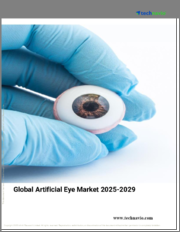
|
시장보고서
상품코드
1380452
세계의 인공 망막 시장(2023-2030년)Global Artificial Retina Market 2023-2030 |
||||||
세계 인공망막 시장은 예측 기간(2023-2030년) 동안 8.1%의 CAGR을 나타낼 것으로 예상됩니다. 인공망막 시장의 성장은 노화성 황반변성 및 망막색소변성증과 같은 망막 질환의 유병률 증가와 고급 안과 치료에 대한 수요 증가에 기인합니다. 또한, 인공망막 장치의 기술 발전, 의료비 지출 증가, 이러한 장치의 가용성에 대한 환자의 인식이 높아짐에 따라 향후 몇 년동안 시장 성장을 가속할 것으로 예상됩니다. 세계보건기구(WHO)에 따르면 세계적으로 최소 22억 명이 근시 또는 원시 장애를 가지고 있습니다. 이 중 최소 10억 명은 시력 장애를 예방할 수 있었거나 아직 대처하지 못하고 있습니다. 세계 수준에서 시력 장애와 실명의 주요 원인은 굴절 이상과 백내장입니다.
부문별 전망
연구기관이 세계 인공망막 시장에서 큰 비중을 차지할 것으로 예상
최종 사용자 중 연구기관 부문은 세계 인공망막 시장에서 상당한 점유율을 차지할 것으로 예상됩니다. 이 부문의 성장은 더 나은 고급 치료에 대한 수요가 증가함에 따라 기업과 연구 기관이 더 나은 개선된 장치를 연구하고 추적하는 데 더 많은 노력을 기울이고 있기 때문입니다. 예를 들어, 2020년 6월, 홍콩과학기술대학교(HKUST) 과학자들이 이끄는 국제팀은 기존 바이오닉 아이보다 더 나은 능력을 가진 세계 최초의 3D 인공 안구를 개발하여 휴머노이드 로봇에 시력을 부여하여 시각 장애를 가진 환자들에게 새로운 희망을 가져다 줄 수 있습니다. 시각장애를 가진 환자들에게 새로운 희망을 가져다주고 있습니다.
지역별 전망
세계 인공망막 시장은 북미(미국, 캐나다), 유럽(영국, 이탈리아, 스페인, 독일, 프랑스, 기타 유럽), 아시아태평양(인도, 중국, 일본, 한국, 기타 아시아 지역), 기타 지역(중동 및 아프리카, 라틴아메리카) 등 지역별로 세분화되어 있습니다. 세분화되어 있습니다. 그 중에서도 유럽은 경제 개척과 영국, 독일 등의 정부 지원 증가로 인해 세계 시장에서 두드러진 점유율을 차지할 것으로 예상됩니다. 예를 들어, 2022년 1월, 시각장애를 가진 영국 여성이 바이오닉 아이 임플란트를 통해 시각 신호를 감지할 수 있게 되었습니다. 다게넘에 사는 이 여성은 지리적 위축증을 앓고 있습니다. 이 증상은 가장 흔한 형태의 건성 노화 황반변성(AMD)으로 세계 수백만 명이 시력을 잃을 수 있는 질환입니다.
북미는 인공망막 세계 시장에서 상당한 CAGR로 성장할 것으로 예상됩니다.
모든 지역 중 북미는 예측 기간 동안 상당한 CAGR로 성장할 것으로 예상됩니다. 이 지역의 성장은 강력한 의료 인프라와 의료 산업의 연구 개발에 대한 높은 지출에 기인합니다. 예를 들어, 2020년 1월, 피츠버그 대학 의료 센터(UPMC)는 영구적인 실명으로 이어지는 질병인 진행성 황반변성(AMD) 환자의 부분적인 시력 회복을 위한 임상시험의 일환으로 미국 최초의 환자에게 새로운 무선 망막 장치를 이식했습니다. 이와는 별개로, 이 지역에서는 주요 기존 기업들의 제품 출시가 꾸준히 증가하고 있으며, 이는 이 지역의 의료 부문을 더욱 발전시키고 시장 성장을 가속하고 있습니다. 미국 국립의학도서관에 따르면, 알파 AMS 망막하 임플란트는 6명 중 5명의 시력을 개선하고 최대 24개월 동안 그 기능을 유지했습니다. 이식 수술은 여전히 어렵지만, 광간섭단층촬영(OCT) 현미경 안내와 같은 새로운 개발로 인해 수술 절차가 개선되었습니다.
목차
제1장 보고서 개요
- 업계 현황 분석과 성장 가능성 전망
- 조사 방법과 툴
- 시장 내역
- 부문별
- 지역별
제2장 시장 개요와 인사이트
- 조사 범위
- 애널리스트 인사이트와 현재 시장 동향
- 주요 조사 결과
- 추천 사항
- 결론
제3장 경쟁 구도
- 주요 기업 분석
- Aetna Inc.
- 개요
- 재무 분석
- SWOT 분석
- 최근 동향
- Bionic Vision Technologies
- 기업 개요
- 재무 분석
- SWOT 분석
- 최근 동향
- Pixium Vision
- 개요
- 재무 분석
- SWOT 분석
- 최근 동향
- 주요 전략 분석
제4장 시장 세분화
- 세계의 인공 망막 시장 : 제품 유형별
- Epiretinal Implants
- Subretinal Implants ㅍEpineural Implants
- 세계의 인공 망막 시장 : 최종사용자별
- 병원
- 진료소
- 연구기관
제5장 지역별 분석
- 북미
- 미국
- 캐나다
- 유럽
- 영국
- 독일
- 이탈리아
- 스페인
- 프랑스
- 기타 유럽
- 아시아태평양
- 중국
- 인도
- 일본
- 한국
- 기타 아시아태평양
- 세계 기타 지역
제6장 기업 개요
- Altris, Inc.
- Axorus
- Bionic Vision Technologies
- Intelligent Implants, Ltd.
- Labtician Ophthalmics, Inc.
- LambdaVision, Inc.
- Medtronic
- Nano Retina
- Nidek Co. Ltd.
- Optobionics
- Retina Implant AG
- Vivani Medical Inc.
Title: Global Artificial Retina Market Size, Share & Trends Analysis Report by Type (Epiretinal Implants, Subretinal Implants, and Epineural implants), and by End User (Hospital, Clinics, and Research institutes)Forecast Period (2023-2030).
The global artificial retina market is anticipated to grow at a CAGR of 8.1% during the Forecast Period (2023-2030). The growth of the artificial retina market can be attributed to the increasing prevalence of retinal diseases such as age-related macular degeneration and retinitis pigmentosa, along with the growing demand for advanced ophthalmic treatments. Additionally, technological advancements in artificial retina devices, increasing healthcare expenditure, and rising awareness among patients about the availability of these devices are expected to drive market growth in the coming years. According to World Health Organization (WHO), globally, at least 2.2 billion people have a near or distance vision impairment. In at least 1 billion of these, vision impairment could have been prevented or is yet to be addressed. The leading causes of vision impairment and blindness at a global level are refractive errors and cataracts.
Segmental Outlook
The global artificial retina market is segmented on the type and end user. Based on the type, the market is sub-segmented into epiretinal Implants, subretinal Implants and epineural implants. And Based on the end user, the market is sub-segmented into hospital, clinics, and research institutes. Among the type, the Epiretinal Implants sub-segment is anticipated to hold a considerable share of the market, Owing to it better and safety features. It can be implanted and removed through a smaller incision than subretinal implants. This reduces the risk of complications and makes it easier to replace the implant if necessary.
The Research Institutes Sub-Segment is Anticipated to Hold a Considerable Share of the Global Artificial Retina Market
Among the end user, the research institutes sub-segment is expected to hold a considerable share of the global artificial retina market. The segmental growth is attributed to the increasing demand for better and advanced treatment, hence the companies and research institutes are focusing more on research and trails of better and improved devices. For instance, in June 2020, an international team led by scientists at the Hong Kong University of Science and Technology (HKUST) has recently developed the world's first 3D artificial eye with capabilities better than existing bionic eyes and in some cases, even exceed those of the human eyes, bringing vision to humanoid robots and new hope to patients with visual impairment.
Regional Outlook
The global artificial retina market is further segmented based on geography including North America (the US, and Canada), Europe (UK, Italy, Spain, Germany, France, and the Rest of Europe), Asia-Pacific (India, China, Japan, South Korea, and Rest of Asia), and the Rest of the World (the Middle East & Africa, and Latin America). Among these, Europe is anticipated to hold a prominent share of the market across the globe, owing to the economic development coupled with the increasing government support in countries such as UK, Germany, and others. For instance, in January 2022, Bionic eye implant enables blind UK woman to detect visual signals. The woman from Dagenham suffers from geographic atrophy. The condition is the most common form of dry age-related macular degeneration (AMD), which affects millions of people worldwide and can cause loss of sight.
The North America Region is Expected to Grow at a Significant CAGR in the Global Artificial Retina Market
Among all regions, the North America regions is anticipated to grow at a considerable CAGR over the forecast period. Regional growth is attributed to strong healthcare infrastructure and high expenditure in R&D in medical industry. For instance, in January 2020, University of Pittsburgh Medical Center (UPMC) implanted the first patient in the US with a new wireless retinal device as part of a clinical trial aimed at restoring partial sight to patients with advanced age-related macular degeneration (AMD), a disease that leads to permanent blindness. Apart from this, the regions is witnessing a steady increase in product launches by key established companies, further advancing medical sector in the region, in turn propelling the market growth. According to National Library of Medicine, the Alpha AMS subretinal implant improved visual performance in 5 of 6 participants and has exhibited ongoing function for up to 24 months. Although implantation surgery remains challenging, new developments such as optical coherence tomography (OCT) microscope guidance added refinements to the surgical technique.
Market Players Outlook
The major companies serving the global artificial retina market include: Altris, Inc., Axorus, Bionic Vision Technologies, Intelligent Implants, Ltd., Labtician Ophthalmics, Inc., LambdaVision, Inc., Medtronic, Nano Retina, and others. The market players are considerably contributing to the market growth by the adoption of various strategies including mergers and acquisitions, partnerships, collaborations, funding, and new product launches, to stay competitive in the market. For instance, in April 2023, RetinAI and Boehringer Ingelheim have joined forces to advance the identification and treatment of geographic atrophy using artificial intelligence (AI). This partnership holds the potential to revolutionize treatments by tailoring them more precisely to each patient's specific condition. Ultimately, this collaboration aims to transform the lives of individuals affected by retinal diseases.
The Report Covers:
- Market value data analysis of 2022 and forecast to 2030.
- Annualized market revenues ($ million) for each market segment.
- Country-wise analysis of major geographical regions.
- Key companies operating in the global artificial retina market. Based on the availability of data, information related to new product launches, and relevant news is also available in the report.
- Analysis of business strategies by identifying the key market segments positioned for strong growth in the future.
- Analysis of market-entry and market expansion strategies.
- Competitive strategies by identifying 'who-stands-where' in the market.
Table of Contents
1. Report Summary
- Current Industry Analysis and Growth Potential Outlook
- 1.1. Research Methods and Tools
- 1.2. Market Breakdown
- 1.2.1. By Segments
- 1.2.2. By Region
2. Market Overview and Insights
- 2.1. Scope of the Report
- 2.2. Analyst Insight & Current Market Trends
- 2.2.1. Key Findings
- 2.2.2. Recommendations
- 2.2.3. Conclusion
3. Competitive Landscape
- 3.1. Key Company Analysis
- 3.2. Aetna Inc.
- 3.2.1. Overview
- 3.2.2. Financial Analysis
- 3.2.3. SWOT Analysis
- 3.2.4. Recent Developments
- 3.3. Bionic Vision Technologies
- 3.3.1. Overview
- 3.3.2. Financial Analysis
- 3.3.3. SWOT Analysis
- 3.3.4. Recent Developments
- 3.4. Pixium Vision
- 3.4.1. Overview
- 3.4.2. Financial Analysis
- 3.4.3. SWOT Analysis
- 3.4.4. Recent Developments
- 3.5. Key Strategy Analysis
4. Market Segmentation
- 4.1. Global Artificial retina Market by Product Type
- 4.1.1. Epiretinal Implants
- 4.1.2. Subretinal Implants
- 4.1.3. Epineural Implants
- 4.2. Global Artificial retina Market by End User
- 4.2.1. Hospital
- 4.2.2. Clinics
- 4.2.3. Research Institutes
5. Regional Analysis
- 5.1. North America
- 5.1.1. United States
- 5.1.2. Canada
- 5.2. Europe
- 5.2.1. UK
- 5.2.2. Germany
- 5.2.3. Italy
- 5.2.4. Spain
- 5.2.5. France
- 5.2.6. Rest of Europe
- 5.3. Asia-Pacific
- 5.3.1. China
- 5.3.2. India
- 5.3.3. Japan
- 5.3.4. South Korea
- 5.3.5. Rest of Asia-Pacific
- 5.4. Rest of the World
6. Company Profiles
- 6.1. Altris, Inc.
- 6.2. Axorus
- 6.3. Bionic Vision Technologies
- 6.4. Intelligent Implants, Ltd.
- 6.5. Labtician Ophthalmics, Inc.
- 6.6. LambdaVision, Inc.
- 6.7. Medtronic
- 6.8. Nano Retina
- 6.9. Nidek Co. Ltd.
- 6.10. Optobionics
- 6.11. Retina Implant AG
- 6.12. Vivani Medical Inc.



















